Adapted from Paul d’Orléans’ book ‘The Chopper: the Real Story’
It’s the most famous motorcycle in the world, period. Show someone a photograph of the ‘Captain America’ bike from ‘Easy Rider’, and everyone knows what they’re looking at. Show them Rollie Free stretched out in a bathing suit over his Vincent at Bonneville in 1948, and they’ll laugh, but won’t know a thing about the bike or the man. Show them TE Lawrence on his Brough Superior, and they’ll recognize neither the quizzical WW1 hero, nor his Brough Superior. The Captain America chopper transcends its own story; nobody needs to have seen the film, nor recognize Peter Fonda, to understand they’re looking at an icon, a magical talisman of Freedom. Such is the power of the machine’s image, and its place in the cultural history of motorcycling around the world. Far more people idolized that motorcycle than ever saw the film; all they needed was a photograph of Dennis Hopper (on the ‘Billy’ bike) and Peter Fonda, riding through the anonymous landscape of the American West, modern day cowboys roaming the land; free, just free.
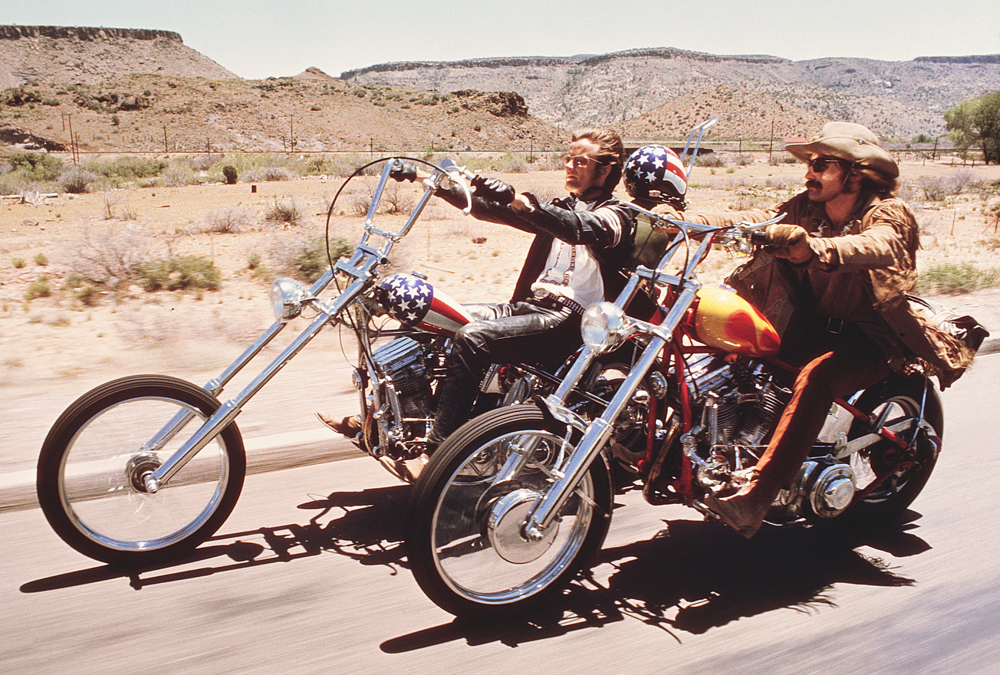
If anyone thought to ask ‘who built that?’ (and few did), they might have assumed Peter Fonda built it, but most admirers of Captain America were simply glad it existed, as if it had been delivered from the gods. Its lines and proportions are perfect, as is the American flag paint job, which slip under one’s skin and electrify subconscious associations: the cowboy, the outlaw, America, freedom, power, speed, sex, drugs and rock music. Those admiring the Easy Rider choppers didn’t want to be Peter Fonda, they wanted to be Captain America. They wanted to own that bike and ride it and eat it and absorb everything the bike stood for into their very beings, to become the gods that bike promised we could become. It is a powerful work of art, a coveted, elusive object, copied a thousand times all over the globe, but it cannot be truly captured, as it exists only in the realm of dreams.
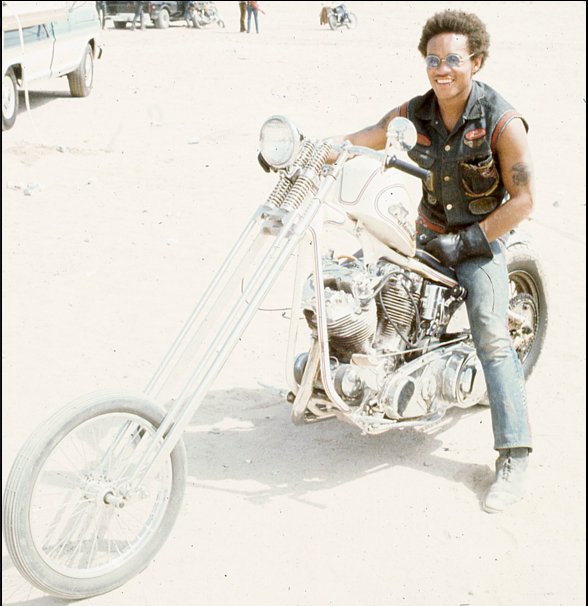
Who Is Soney Vaughs?
Clifford A. ‘Soney’ (the spelling is his mother’s) Vaughs was born in Boston on April 16th, 1937, to a single mother who was 16 at the time; she’d been kicked out of the family compound in Gibbsboro, New Jersey, for her unwed status, so moved to Massachusetts to be near a more sympathetic aunt. As a boy, Cliff attended the Boston Latin School, from whence he derived a particular pattern of speech, and a facility with language – Cliff was specific about his words, and at times prickly in their usage. In 1953 he joined the Marines, and tested so highly he was scheduled for flight training, and sent to a base Pensacola, Florida. He was immediately rebuffed by the CO of the base, who turned him right back to Boston, refusing the possibility of a black pilot on his watch, and an integrated flight training school. “Things were different in Florida than Boston”, noted Cliff. Instead, he was transferred to Electronics Technician School at Great Lakes NTC. After 3 years of active duty, he worked at the Boston Navy yard on the cruiser ‘Boston’ as a technician on its radar installations for guided missiles. After the USMC he took a job with Raytheon, working on the guidance systems of Sparrow and Hawk missiles. He decided to further his education at Boston University for his BA, then trekked to the University of Mexico in Mexico City for his Masters, driving his Triumph TR3 all the way from Boston. “At the time they offered a progressive Latin American Studies graduate Program. Plus I liked driving my TR3 from Boston to Mexico City. I had family friends living in Cuernavaca; buddies from the ‘Village’. Acapulco on weekends.” He hung out, of course, with future F1 racing legends the Rodriguez brothers (Pedro and Ricardo), who seemed immune from the law’s attention while driving unregistered Formula racing cars on the streets of the District Federal.
1961: First Chopper
By 1961 he “went from Mexico to Santa Monica where, I had a sort of ‘drawing room.’ [An] art, literary cocktail scene just as I had on a regular basis in Boston. Several friends came to visit. In those days we were called Bohemians.” In Santa Monica, living very close the beach, he had purchased an AJS Model 18S enduro for $300 from Motorcycles Unlimited on Pico Blvd, for plonking around town. His 5 uncles all rode Harley-Davidsons back in New Jersey, so motorcycling was in his blood. The Ajay had ‘knobbies’, which led to a slide-out on Dead Man’s Curve on Sunset Blvd; luckily he’d worn a helmet, for he could hear it clonking on the ground as he slid. The AJS took him and his then wife Wendy down to Tijuana for the Tecate Enduro races, and encountered about 2000 other riders, most of whom had ridden from SoCal. “As I rode home two-up on the Ajay, it seemed like all 2000 riders went roaring past us on Hwy 1. So I sold my AJS, and bought a Knucklehead chopper from a friend who needed some money. When I got the Knuck, I knew nothing about motorcycles really. Nobody in Santa Monica knew anything about them, but I’d heard of Ben Hardy in South Central, and another guy named Wes who had a shop too, but was less popular. When I needed parts, Ben Hardy would send me to Jim Magnera of MC Supply; it turned out Jim had subsidized Ben to open his shop. Black shops at the time couldn’t buy parts directly through the Harley-Davidson dealer, so Magnera became the small shops’ conduit for Harley parts.” He met the Chosen Few MC while sleeping by his chopper on the side of Highway 99 en route north; they invited Cliff to join them on a run to Oakland to visit the East Bay Dragons MC, and after they returned, Cliff was presented with his CFMC ‘club cut’, “I didn’t have to prospect, they just made me a member.”
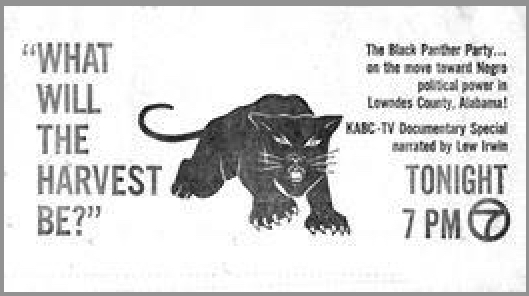
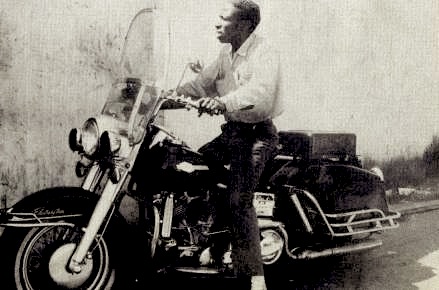
Recruited to the Cause
Vaughs admits that when Dr Martin Luther King Jr led the March on Washington for Jobs and Freedom in 1963, “I was building a chopper in my backyard. I knew it was happening, but I hadn’t been politicized. Boston had nothing going on in terms of race at the time, it was all mixed race among my friends. We were all the American refugees; Italians, Jews, blacks, etc. I’d heard about the Freedom Rides, but, being from Boston, I thought, ‘What could happen?’ Cliff met Civil Rights legend Bob Zelner, the first white field coordinator for the Student Nonviolent Coordinating Committee (SNCC), when he passed through LA in 1963 on a fundraising tour. Vaughs was recruited to the SNCC cause, and drove his 1953 Chevy half-ton pickup to Mississippi. Of course, being Cliff, he laid stainless steel in the truck’s bed, with teak runners, and a white fiberglass tailgate with ‘SNCC’ in big black letters. Outrageous, and an instant target, “In the window I had an ‘Ole Miss’ [University of Mississippi] sticker; I’ve been shot at many times.”
“They took a shot at us from behind and missed.”
Even more outrageous was riding his blue Knucklehead chopper to Arkansas in 1964, with a white girl on the back. “The fiery ending of ‘Easy Rider’ is an example of art imitating life. I was riding my chopper on the highway between Pine Bluff and Little Rock, pursuing an assignment for SNCC to initiate a school boycott there. I had with me a staff member of the Arkansas Project, a Miss Iris Greenburg. A pickup truck passed us going in the opposite direction, stopped and turned around. They took a shot at us from behind and missed. They didn’t pursue us any further…so I lived to tell this tale.” Of all the crazy motorcycle tales one hears about the 1960s, this is perhaps the hairiest story of all, and a sign that Soney was both a civil rights volunteer and a bit of a provocateur. “I may have been naïve thinking I could be an example to the black folks who were living in the South, but that’s why I rode my chopper in Alabama. I’d visit people in their dirt-floor shacks, living like slavery had never ended, and it was very tense; I was never sure if the white landowners would chase me off with a shotgun. But I wanted to be a visible example to them; a free black man on my motorcycle.”
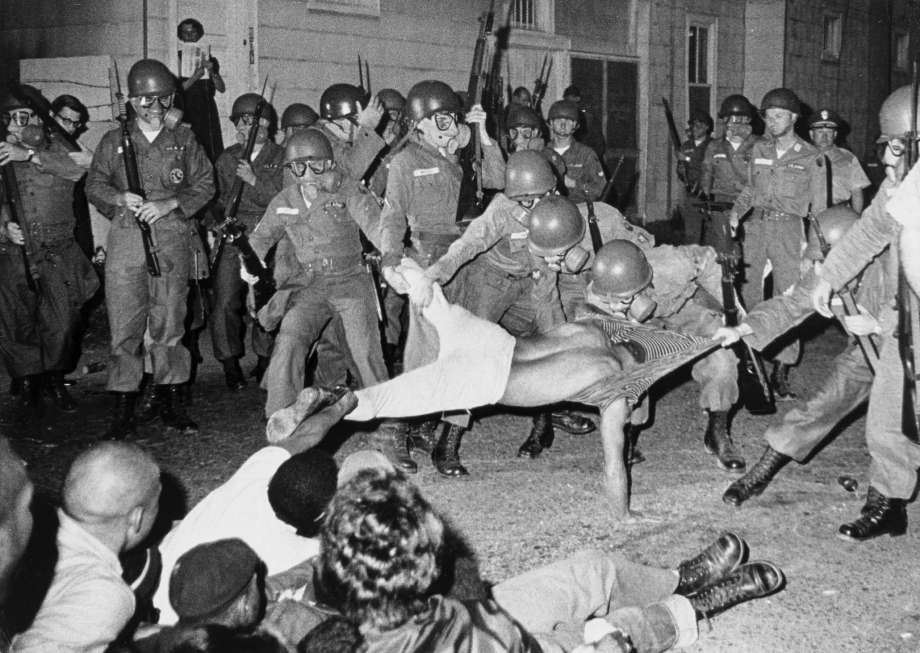
“You are crazy,” John Lewis said, “I will not march next to you.”
He carried on with SNCC through 1964, which is when he met photographer Danny Lyon (of ‘The Bikeriders’ fame), who snapped the infamous photo of Vaughs being bodily lifted, shirtless and shoeless, by no less than 6 helmeted National Guardsmen in Cambridge, Maryland, on May 2nd, 1964. “Stokely Carmichael is holding my other leg in that photo”, says Cliff. “Later on, Danny Lyon lived next to me in Malibu.”
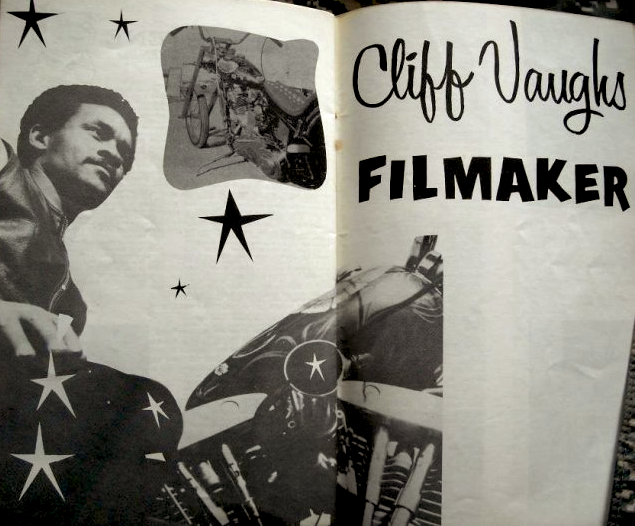
The Origin of ‘Easy Rider’
Vaughs began making documentary films with “What Will the Harvest Be?”, narrated by Julian Bond, about the rise of Black Power (a term Stokeley Camichael popularized) in the South, which included interviews with Dr Martin Luther King Jr, Carmichael, and Julian Bond, which was aired on ABC-TV in the mid-60s. He was also working at Los Angeles radio station KRLA, which is how he met Peter Fonda. “Peter was arrested for possession of marijuana. I was mildly amused that so much interest was engendered by the incident, considering the number of citizens detained and incarcerated for smoking ‘pot’. We chatted for a while at the courthouse and I called in my story. He was interested in my hobby: designing and building motorcycles. It turned out that we lived in the same neighborhood, West Hollywood. I told him I was usually found in my back yard enjoying my hobby.”
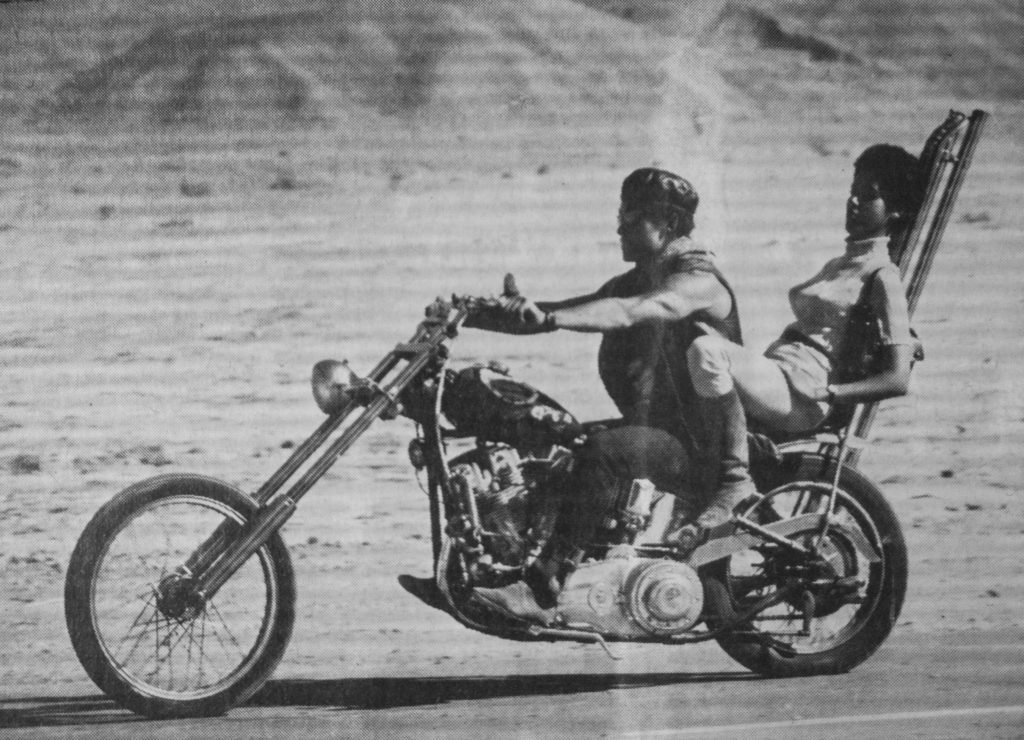
“We ad-libbed a story line: two friends (not quite ‘bikers’), traveling across America seeking adventure”
Elder Pattison de Turk III (henceforth Pat de Turk) remembers,“I moved into Cliff’s house in West Hollywood in the fall of ’67. I was working full time, and preparing to begin a career in computer programming…I met Cliff in 1961 while I was studying at UCLA and riding Harley 45”, and Cliff had an AJS scrambler. I soon had a lime green Knucklehead chopper that I bought for $300 on Venice Blvd. I was in the living room when Peter [Fonda] and Dennis [Hopper] were visiting. Dennis was slightly mad and a motormouth, he was incessant, so he pretty well dominated the conversation, and I was completely intimidated by the situation, I was just Sonny’s friend and all of the sudden here were these movie stars in the room. They came over several times…and of course, there was the ever-present small tapestry on the wall – “Where has my Easy Rider gone?”
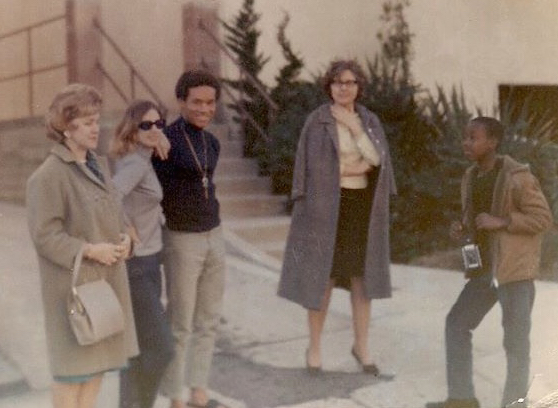
Larry Marcus; the Mechanic
Larry Marcus, mentioned above, was a mechanic, who Vaughs said “knows more about tools than anyone”, and who was also living at Cliff’s house at the time the Easy Rider project began in 1967. “The first time I recall meeting Soney was while I was working as a mechanic at Motorcars by Sutton on Western Ave, the Fiat / Rover/ Jaguar/ Triumph/ Renault dealer, it just a little tiny shop. I used to drive up to Griffith park for lunch. Soney walked in one day to get his Fiat 500 fixed, he was working for KRLA at the time, wearing a hippie shirt and flowered tie. KRLA did a lot of avant garde stuff on TV, things that had never tried before, like Ernie Kovaks. At the shop, he pulled me aside, and said he knew who I was, but didn’t want to acknowledge me as we were both on our jobs; he said we’d met at Goddard College back East, we had mutual friends there. I had been living in Europe in ‘62/’63, but applied to Goddard to stay out of the draft, as I’d been told I’d be drafted immediately if I showed up at a European draft office. After college I moved to Cali in 1966. Anyway, I offered to work after hours on Soney’s Fiat, so he didn’t have to pay the shop rate.”
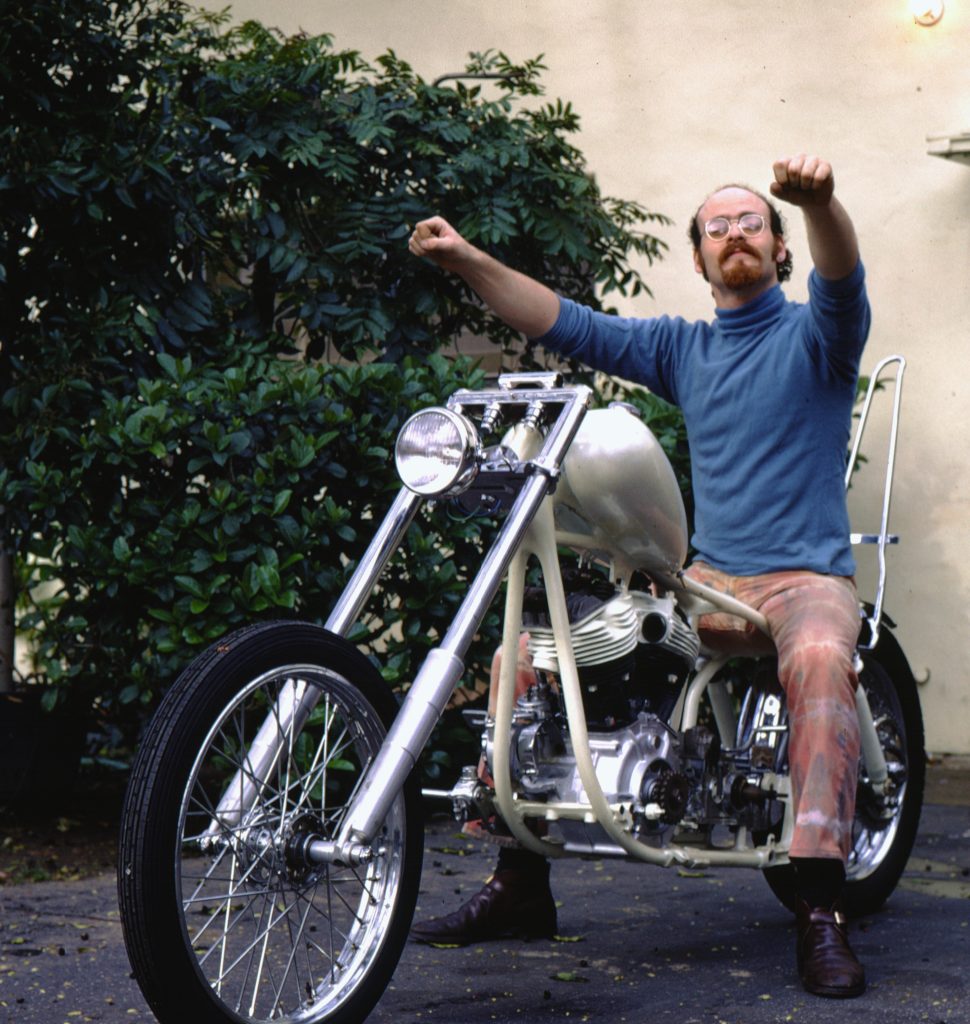
Making ‘Captain America’ and ‘Billy’
Larry Marcus was living with Cliff Vaughs by 1967, when discussion for Easy Rider began. “The title ‘Easy Rider’ was Soney’s idea, taken from a Bessie Smith song from 1928. There was a thing on the wall … a little tapestry hanging, which said ‘Where Has My Easy Rider Gone’ with no question mark, the letters were sewn on, in paper, I’d never seen that kind of art before. A girlfriend of Soney’s made it, long before the film.”
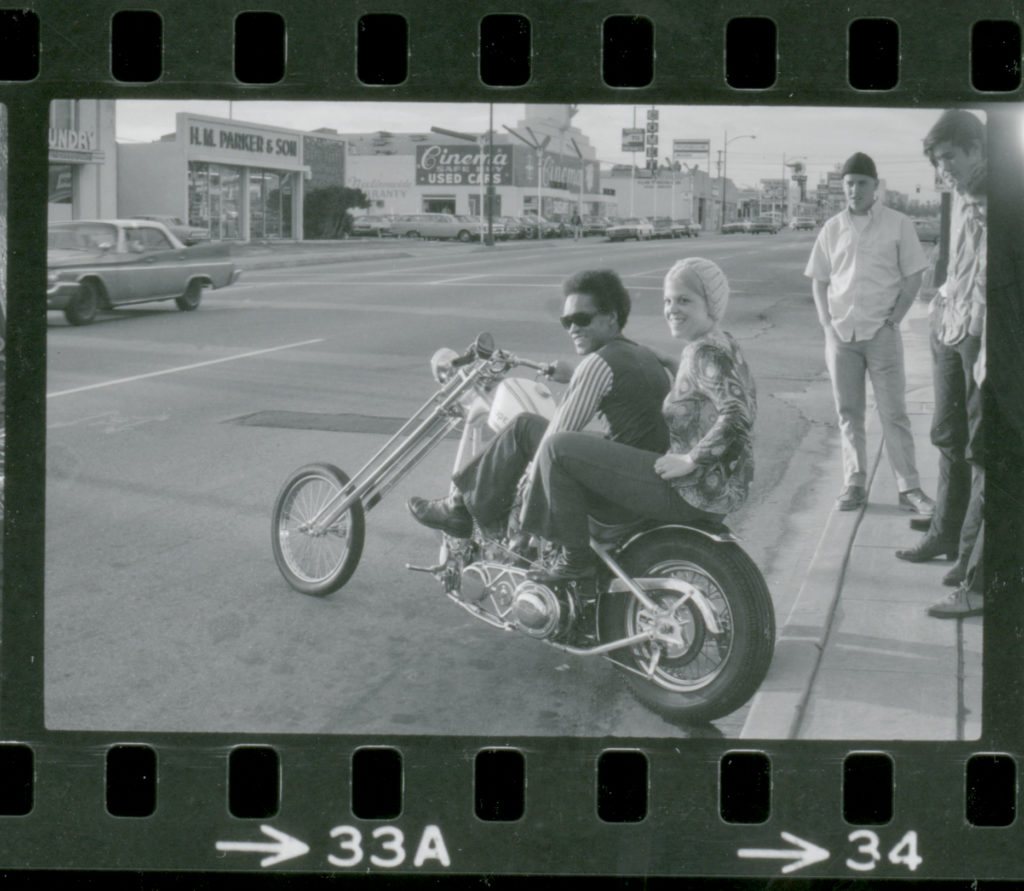
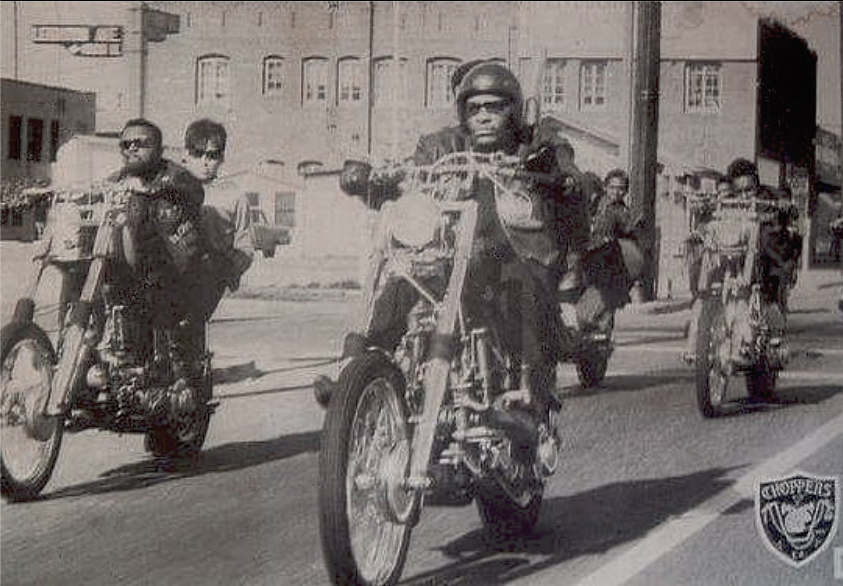
“Ben Hardy built the first two Easy Rider bikes.”
Vaughs’ recalls of the Captain America bike, “When we did the first prototype of the bike it had no front brake, as I never used a front brake, which led to some harrowing experiences, especially with a chromed rear brake drum which would heat up quickly and fade. You’re always working the gearbox to slow down. For the movie, I had to put a hand clutch on the bike, as Peter wasn’t used to a suicide shifter. I could assemble a bike after all the parts were finished in about 6 hours, but it took time for Buchanan’s to build the frames, and Dean to do the painting. But with my resources and contacts through Ben Hardy, we got all our parts finished in 3 weeks. I had the money, and they all knew we were working on a film. In the creation of the bikes we used Buchanan’s for frame fabrication, Dean Lanza for the artwork [painting], Larry Hooper for upholstery, using LAPD junkyard engines, which were rebuilt by Mr. Hardy. Mr. Hardy also designed and constructed one of the fine points on the motorcycles; I had wanted something unique and he built the curved tail light brackets. After I had completed the construction of the machines, the registration (pink slip) was in the name of Pando Company.”
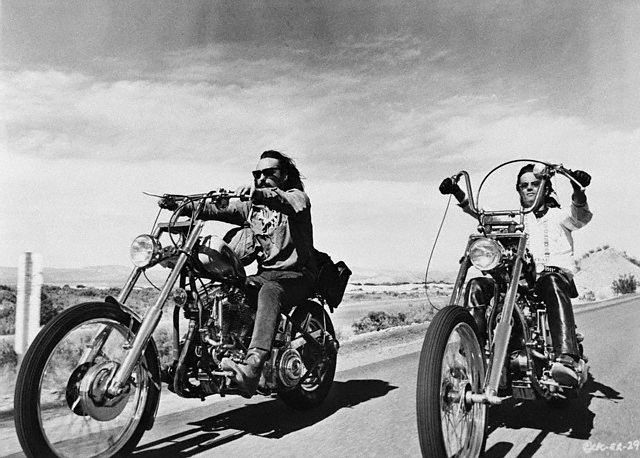
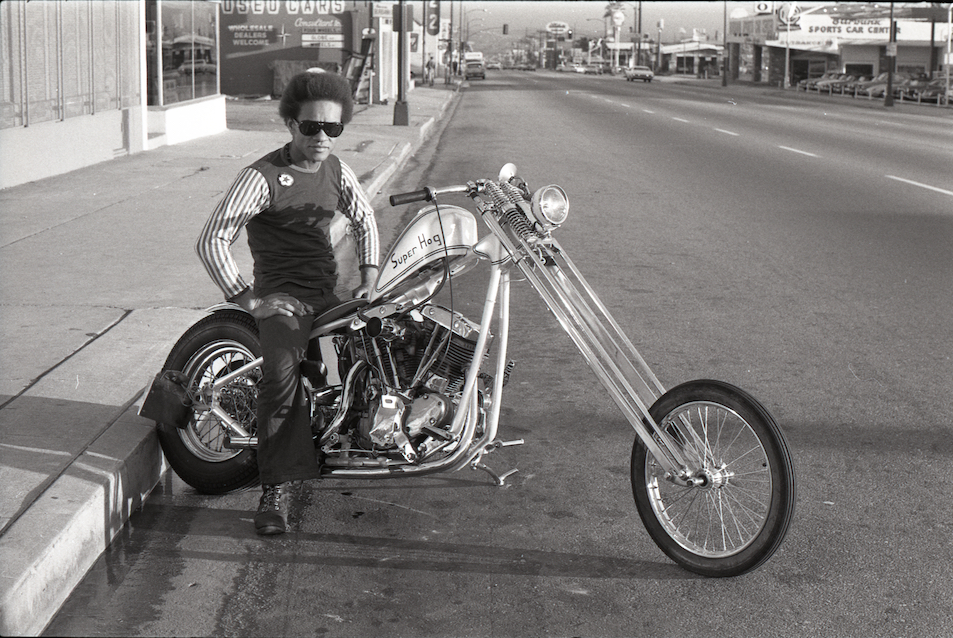
Ad-libbed and Ad Hoc
The actual filming of Easy Rider was notoriously chaotic, with an ad hoc film crew and, as Marcus says, “Terry Southern writing the dialogue on the crew bus between takes!” With Vaughs as co-producer and Marcus working as a sound technician, Marcus recalls his pay rose to $150/week during the actual shooting. “I’m proud to have about a minute of sound in the film, I worked with Les Blank, who was on the second crew with me. When one of our bikes wouldn’t start on the set, we were fired.” He adds, “I worshiped the ground Dennis Hopper walked on, he was an extremely talented guy, but I never got along with Peter.” A deleted scene from the film included Hopper and Fonda, broken down with their choppers on the side of the road, when a black chopper club (members of the Chosen Few) approaches and stops. “We have a situation where the two main characters are riding across country. Their bikes break down and they run into about 50 black cyclists. They are very, very up-tight, scared and shaken up. But, it works out very well because the black cats just say, “Can we help you get some gas?” Everything is very groovy. And that to me seems a real situation. I maintain if that situation can happen and it does in real life there is still some hope. There are many, many people that maintain that it can’t happen. But I’ve seen it happen this way.” But, after Vaughs was fired, this scene was deleted from ‘Easy Rider’, and “there were no African Americans in the film as actors or participants in the production.” Interestingly, Vaughs’ own experience as a black chopper rider echoed the deleted scene; “I never experienced issues around race with bikers. There’s a myth of racism around 1% clubs, but I’ve never experienced it. I was always offered the helping hand of fraternity.” Both Vaughs and Marcus lament the cutting of the ‘Chosen Few’ scene, which to them spoke to the reality of chopper riding in LA at the time. Had that scene not been deleted, it might have altered the perception in the years after ‘Easy Rider’ that choppers were solely a white man’s game, and the cloud of racist associations hovering around this ‘folk art’ motorcycle style might have been cleared away.
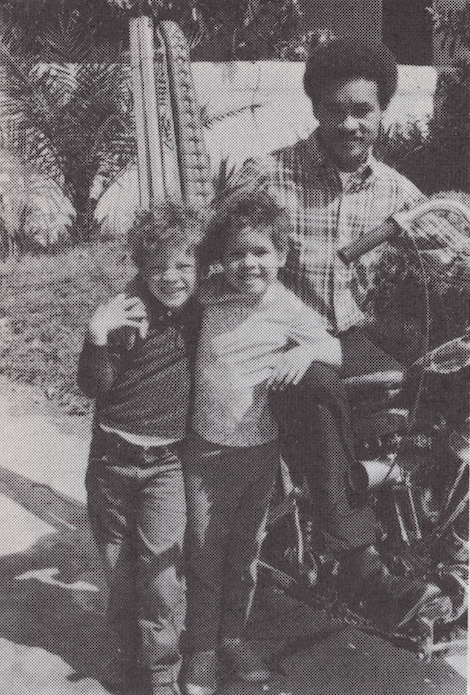
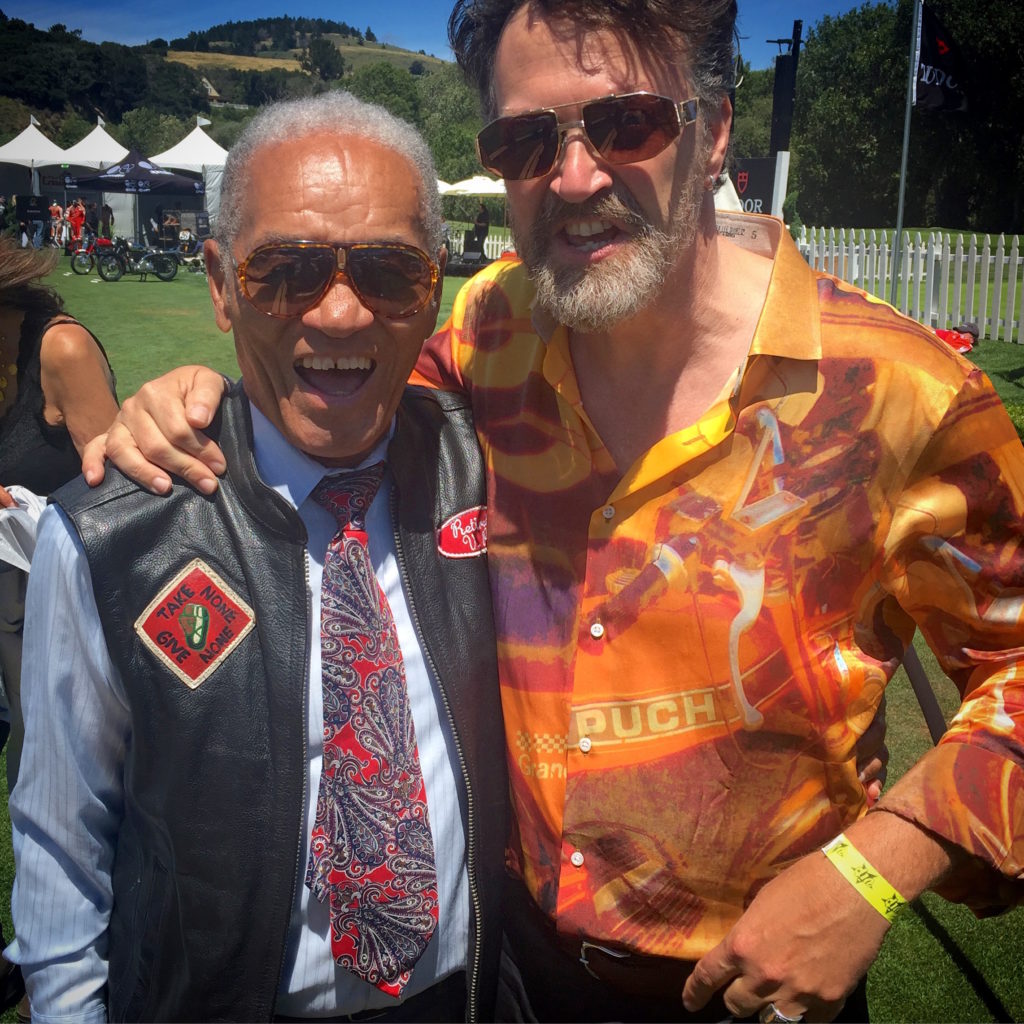
[There are more terrific stories in ‘The Chopper; the Real Story’ – buy it here!]
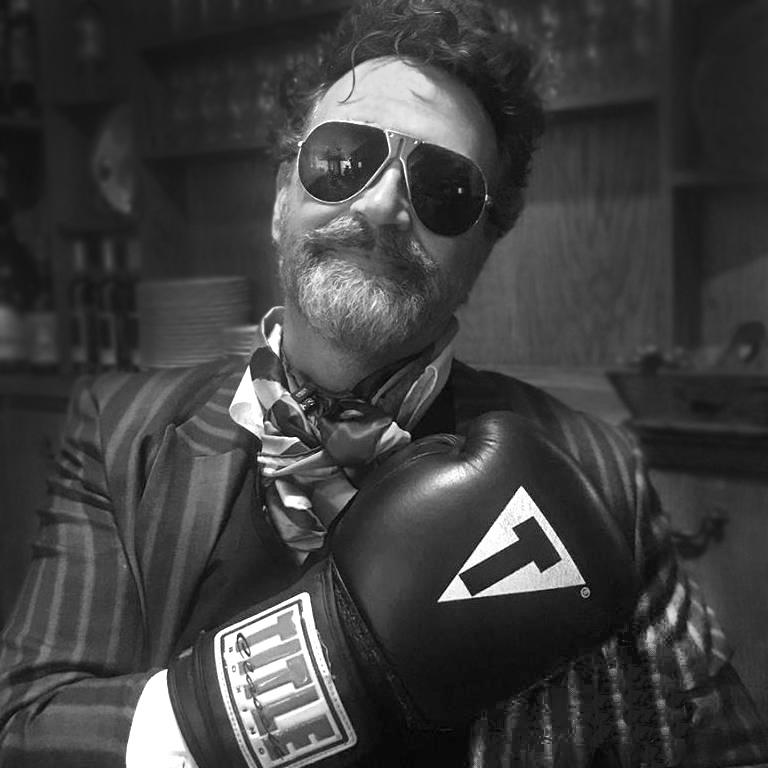
Related Posts
September 17, 2017
The Vintagent Selects: The American Wall Of Death
Director Roberto Serrini takes us…
July 25, 2017
The Vintagent Trailers: Morbidelli – a Story of Men and Fast Motorcycles
Discover the story of the Morbidelli…
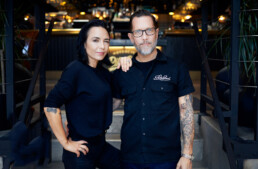
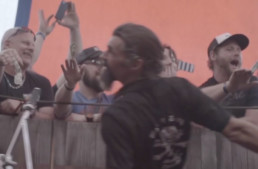
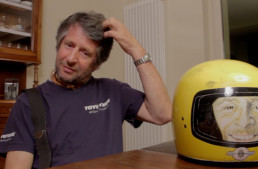
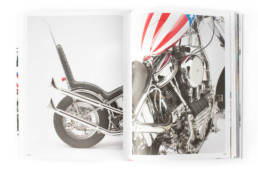
Amazing, truly. Best thing on the Internet. Keep up the good work!
Incredibly interesting. As always, thanks for shining a light on the history and evolution of the machines that we love and the people who made and rode them.
Jesse James : in one of his very rare moments of relevance did an entire show on this subject , but not nearly to the extent you have here Paul , so two thumbs up .
Another moment of Historical ( hysterical ? ) Irony .
Hitler , the supreme Anti Semite being in fact of Jewish descent and 1% er’s , e.g. the White Supremacists riding M/C’s that were in fact created by Afro Americans . Oh and listening to what is in essence music , who’s roots came from Afro American culture as well
Kind of makes one want to laugh on one hand , yet cry on the other knowing so many have received so little credit for that which popular culture now takes for granted .
So again , cheers to you Paul for bringing the subject up here and giving some credit where credit is due
Simply outstanding in every way, even though Cliff’s contribution, so often overlooked in the intervening 40 years since the film’s release,has been covered by several writers seeking to redress the bullshit and fantasy on the subject of the bikes, the film and who was or wasn’t involved. Your article concisely and respectfully sets things to rights. Truly wonderful to see Mr Vaughs is still among us and clearly in fine fettle . . . . let’s hope his fifteen minutes of fame can come into focus before he rides off on the great adventure in the sky . . . thankyou so much for this superb piece !!!
Great story. I had no idea about the origins of those bikes and the myths surrounding them. Thanks for bringing attention to this.
Thumbs up Paul. Well done. I was at the first showing in Hollyweird waiting to ship over to Southeast Asia. We were more than a little pissed off at the ending. We shouldn’t have been surprised though. When you show people who always thought they were free that truely you are they get scared and react as they did. Fear and ignorance are a dangerous combination. Good work my friend.
I like your bit on Cliff Vaughns and recall as a kid watching ‘bob-jobs’ in awe as they terrified folks in Provincetown.
Best Regards, Robert
Paul,
Best article on this subject I’ve read to date. I had the honor of meeting Hopper on two occasions. On one occasion in Venice Ca. he was looking at my panhead outside a local eatery. I introduced myself and we spoke about bikes for a few. He mentioned Hardy and Vaughs.
” A lot of people think choppers were a white dudes game, but just like rock and roll, the brothers had one up on us.”
I am paraphrasing of course, but I’ll never forget that. It was the first time I had ever heard it.
Thank god for cats like these and of course Sugar Bear.
Paul:
As always an extremely well written and informative article.
Thanks again, Jim A.
“Danny Lyon and I shared the beach in Malibu for a time. I didn’t know he was a rider; although I remember his picture of a Triumph displayed at the museum.
I left the US in 1975. No real contact with my civil rights movement cronies.
The questions around ER were generated mainly because I wasn’t there…
I must say I am thrilled [with your article]. All the pieces are falling together. I’m sending the link to your piece on Vintagent to my kids.”
This is a great article! I met the man and has a wonderful story to tell. I must say this “Cat” has a lot more adventures to share with all of us. He was a good friend. Thank You for sharing his story for a new generation to know about the passed.
Felix
Great post. The prize for winning the ‘Tricycle race’ at my high school during ‘twerp-week’ or whatever it was called, was an Easy Riders poster. 40 some years on, I’m still ticked off at the guy that stole it before I could collect it.
Such an interesting post, great reseach and links. Your site really is my #1 bike site, I really enjoy my weekly visits, thank you and keep up the great work!
Very good article. As a sidenote, I was stationed with the USN, living at Boling AFB in Washington, D.C. when “Easy Rider” was released and I saw it at that time. Shortly thereafter, I went to the D.C. Auto Show (don’t remember the exact name). On display was a Captain America cycle and, not knowing that the originals had been stolen, it was my assumption at the time that it was the original. Perhaps this was one that Dan Haggerty built (?). While there, I also bought an Easy Rider poster, the one shown in your article, which I still have after 43 years!
Mr. Vaughs involvement in the building of the bikes appears at odds with several interviews I’ve conducted. Look at the ‘Billy Bike” and then look at the dozens of of similar bikes Benny Hardy built at the time. That was pretty much a ‘signature’ look of his at the time. I know Mr. Vaughs was involved between the studio and Mr. Hardy, but I find it unlikely he would have designed and built the two most iconic choppers ever and then just stopped.
@Englishman;
Does it seems so outlandish that a talented young film maker and chopper builder, who was an associate producer of ‘Easy Rider’ and a partner in Pando Films, should have designed these two machines?
Its understandable there is confusion today about the ‘Easy Rider’ bikes, especially as Cliff Vaughs effectively disappeared from the film/bike scene by 1973, when he left the USA. I’ve conducted a few interviews myself, of people who knew Cliff during this period, and all have independently and voluntarily confirmed his role in the creation of ‘Easy Rider’, and the design of the bikes.
Cliff is quite clear on his relationship with Benny Hardy – as a mentor- which must of course mean a stylistic influence. Cliff is also clear that he designed the bikes, and subcontracted the building of them to several people, including Benny Hardy. Cliff built choppers with Hardy before ‘Easy Rider’, and acknowledges his help and influence, but is firm in his claim as designer of the ‘Billy’ and ‘Captain America’ bikes. I have no record that Hardy ever claimed thus.
Peter Fonda himself finally acknowledged Cliff’s contribution in a 2011 letter to Cliff…
I presume you read the rebuff a year ago “Who really created Easy Rider”.
http://dennishopperbook.tumblr.com/post/15764426419/who-really-created-easy-rider
During my interviews with people who were there, Mr Vaughs (known as “Sonny” amongst the biker community there), was a 100% film guy with very little involvement in building motorcycles. I know Benny Hardy did not like the ‘Captain America” bike much, but it was what Fonda wanted more than anything.
I guess the absolute truth will never be known, I’m fairly convinced (as is Sugar Bear) that Benny built the two bikes entirely. Benny was the sort of guy that would never ‘share’ a build, it was his way or no way. There appears to have been a couple of ‘lookalike’ bikes put together for destruction in the movie. I’m not sure what Mr. Vaughs motivation was. Just like Peter Fonda and Dan Haggerty have “certified” several Captain America copies as “authentic”. What is certain, the two bikes were stolen and likely parted out before the movie hit the screen.
Benny was not happy with the lack of credit and never built another chopper. Sugar Bear does own a really nice Panhead built by Benny though, you should check it out in his museum sometime.
Hi Englishman,
thanks for the note; I didn’t see your article, which is very interesting. As far as I know, the only mention Fonda made of ‘who built the bikes’ was on the Tavis Smiley Show last year, where he acknowledged ‘a couple of black guys from Watts’ built the choppers. Proper credit for these incredibly important machines was clearly not a priority for him…but I’ve met Fonda several times, and this doesn’t surprise me. I never met Dennis Hopper.
I’m hoping to interview Cliff further for his thoughts, not just about ER, but his experience in the chopper scene in the 60s/70s, his friendship with photographer Danny Lyon, his experience in SNCC, etc.
After I published Cliff’s article, I was contacted by three people via Facebook and my website, who claimed to know Cliff during this period. Each of them gave credible confirmation of Cliff’s role in the film, and his activities in LA at the time; none had spoken with or heard from Cliff in the intervening years, and were glad to hear he was still alive. The fact that he’s not ‘known’ today bears no relation on what happened over 40 years ago…but what happened so long ago is also difficult to parse at this point.
I have no doubt that Hardy had – at the very least – a critical role in the ‘look’ AND building of the ER bikes. I also don’t have much reason to doubt Vaughs for claiming the ‘design’ of the bikes…which could have been a paper sketch… I haven’t pursued this further, but will. No doubt Hardy deserves credit even if it’s acknowledged Vaughs designed the bikes.
I think everyone can agree that if it weren’t for Hardy, there would be no ‘ER’ bikes in that particular configuration, such was his importance at the time. Exactly ‘who decided what’ might be less important if we all agree that more than one person was involved, and quit focusing on ‘the one guy’…as there wasn’t ‘one guy’…and never is in such a build. In my dealings with other, famous custom builders, its always the front man who gets the credit, and a lot of talented people get left in the shadows. Thus it was with Peter Fonda… let’s keep in touch to bring all the information together, and see what we can make of it.
(Jan 16, 2013)
I note that the discussion still rages. I’m sending you a note I wrote ages ago which lists all the contributors to the finished product. It seems fatuous that people still contest the origin of the ‘Easy Rider’ bikes. When I was fired after the New Orleans “shoot” I realized that I had never met in person Raphaelson and Snyder. No blacks in this film about America.
I built (you know) bikes in my back yard in West Hollywood as a hobby. My work for the [film] industry was always my main concern. My show “The Credibility Gap” won me an AP award for the “Most Creative Presentation of the News”
The same year 1969 I received another AP award for the documentary “Berkeley Third World or Third Reich.”
I opened the Industry unions to fair hiring practices. #IATSE (cameraman’s union), the Networks – NBC, CBS, ABC – through due process in the Courts. The above were ordered by the court to cease discriminating by race and gender as a result of my lawsuit and to establish an apprenticeship program/outreach for all minorities. As an aside: the cameraman’s Union President asseverated: “No niggers are coming into my Union.”
My application to NBC Network was rejected in the same language.
The day of the announcement of my Union membership my fellow Cameramen mobbed me at the Governors, (Reagan) Press Conference in Santa Barbara. Pummeled me and smashed my cameras.
– Cliff Vaughs
My father Dean Lanza built and painted both bikes in wild angels (1966) and Easy Rider (1969) I have kept his photos for over ten years after he passed. http://www.flickr.com/photos/93120471@N02/
I am a Lover of Riding and viewing Motorcycles from around the World. Thank-you for this article. I was born in 1969, so I grew up watching Easy-Rider, this movie is the Major reason I ride Motorcycles today. It is nice to know that African Americans had some effect on the creation of the most famous motorcycle of my life time. I ride in an integrated Motor cycle club. I am glad we have no such clause in our membership.
Cliff Vaughs ; Ride in Peace [ I doubt Cliff will be resting much of anywhere ] Thank the small metal gods Paul d.O had the sense to finally bring some of the credit so long overdue to you . May all your rides be filled with the knowledge that some of us know the truth .. thanks again in no small part to Mr d’Orleans
Wow. Fascinating. Well done, Pd’O.
A thoughtful article indeed .
I remember the first time I saw ‘Easy Rider’ in the theater, maybe in 1971, the second release I’d guess .
I always hated the ending because it so clearly showed how much of America was at that time .
You had to grow up in the 50’s and 60’s to understand .
There’s an invitational only, black Motocycle event every year called the “Round Up” and a few years ago as I was crossing the Arizona Desert in a 40 year old English jalopy I had to stop to affect repairs in a remote gas station in the middle of nowhere, nothing else there nor for miles around .
I clattered up to the curb and set about working, shortly dozens and dozens of black Motocyclists began streaming into the station, all the white folks jumped in their campers and station wagons and ran off scared .
The Motocyclists saw me working in the heat and came over asking me :
“? you okay man ?” . (yes, I’m fine, just fixing a massive oil leak so I can get back to Los Angeles)
” ? you need any help ?” . (no, than you very much)
“? you need any money ?” . (no, I’m good,
“you need something to drink ?” . (no, I have a cooler in the back full of water and ice, take some if you need)
These guys looked like the extras in a bad film but were cleaner than I by far and the sharpest looking bikes I’ve seen in a while, not all choppers but mostly .
They were quite sure I was crazy and / or had sun addled brains, this may be so but I was okay and not afraid to ask for help when I need it .
All these rough, tough guys were coming home from the Roundup and took the time to make sure I didn’t die out there in the 120* heat .
When I was finished and went inside to wash my greasy hands the two white girls behind the register asked if I wasn’t afraid they were going to kill me ? . (of course not, Motocyclists are typically the most generous and helpful people you’ll ever meet, I’ve been riding 49 years .)
I’ve been stuck in the Desert a few times and it always seems that average working class black folks are the first to stop to check on me .
FWIW, I’m pasty white, blue eyes (my Sweet calls me her ‘Blue Eyed Devil’) and before it went gray I had blond hair .
Don’t be afraid of new and different things, places or people ~ that’s un American .
-Nate
Interesting! Among Cliff’s forgotten contributions to Easy Rider was a scene where Fonda/Hopper are broken down beside the road, and a Black chopper club arrives to help them out; it was a play on exactly the tensions you noted, which were high in the late 1960s, and are still high today. Cliff, as a long-time civil rights workers, saw the medium of film as an excellent method to ‘show not tell’ that racial divisions are an illusion, but in the end Columbia, Hopper, and Fonda were not interested in that story, only the story of two white guys on bikes, and “in the end, no African-Americans were used in the production or cast of Easy Rider” – Cliff Vaughs.
And in the end, Peter Fonda personally erased the incredibly significant contribution of Vaughs/Hardy to the film by taking the credit for the purchase of the Panhead, and design/building (oh what fabrication chops!) of the choppers for Easy Rider. That is difficult to forgive…although he did finally admit in these pages in 2011 that Cliff had been a significant contributor to the film.